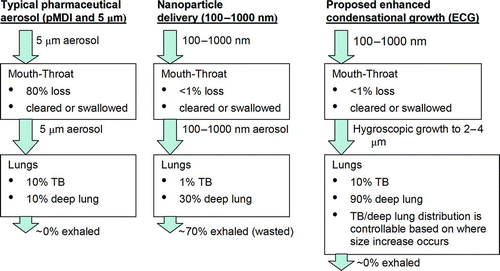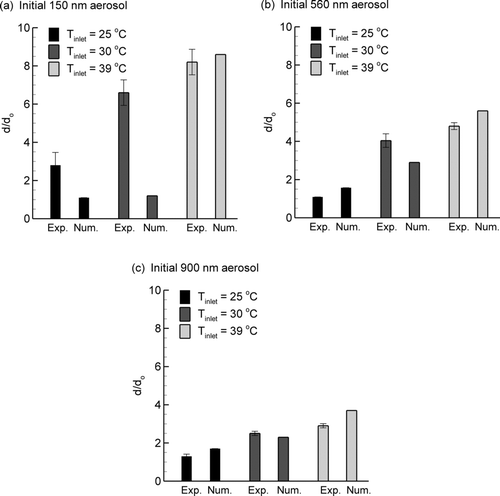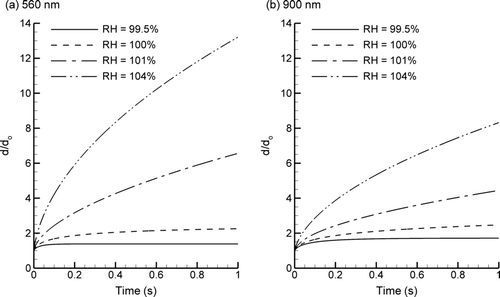Figures & data
FIG. 1 Comparison of standard pressurized metered dose inhaler (pMDI) and nanoparticle delivery performance with the proposed enhanced condensational growth (ECG) approach. The standard and nanoparticle delivery methods either have high mouth throat (MT) deposition or allow a significant fraction of the aerosol to be exhaled. In contrast, the ECG approach offers both low MT deposition and full lung retention of the inhaled aerosol. Tracheobronchial (TB) versus alveolar deposition can potentially be engineered based on the rate of nanoparticle size increase.

FIG. 2 A model of the in vitro geometry used to evaluate the ECG of submicrometer aerosols. The condensation growth zone was 29 cm in length, which is the approximate distance from the mouth to the main bronchi. Mixing of the aerosol stream with the heated and humidified air produces supersaturation conditions and aerosol growth. Final aerosol mass median aerodynamic diameters (MMAD) were determined with an Andersen cascade impactor (ACI) at the end of the condensation growth zone.

TABLE 1 Experimental flow conditions
TABLE 2 Final droplet mass median aerodynamic diameter (MMAD) based on the in vitro ACI measurements. Standard deviation values based on a minimum of five replicates for each case are reported in parentheses. Estimated initial mass fractions of albuterol sulfate in the 150, 560, and 900 nm droplets were 100%, 31%, and 49%, respectively
TABLE 3 Numerical predictions of final aerosol size and potential for two-way coupling during aerosol growth. Based on the experiments, the numerical model assumed the initial mass fractions of albuterol sulfate in the 150, 560, and 900 nm aerosols were 100%, 31%, and 49%, respectively
FIG. 3 Comparison of experimental measurements and numerically predicted growth ratios of final to initial aerosol diameters (d/do) at three humidified air inlet temperatures for initial sizes of (a) 150 nm, (b) 560 nm, and (c) 900 nm with initial albuterol sulfate mass fractions of 100%, 31%, and 49%, respectively. In vitro error bars represent +/– one standard deviation (SD) of the experimental data. Inaccuracies in the numerical predictions for the 150 nm aerosol case may be due to limitations of the correlation used to predict the surface activity coefficient at higher mass fractions of drug. For most other cases, the numerical model provides a reasonable estimate of the growth ratio.

FIG. 4 Numerical predictions of growth ratios (d/do) over a 1 s period for a range of RH values (99.5–104%), body temperature conditions (Tbody= 37°C), and initial aerosol sizes of (a) 560 nm and (b) 900 nm. Relatively minor changes in the RH condition result in large changes in the rate of aerosol growth and the final size achieved. As a result, ECG appears to be an effective method for changing the size of an aerosol after inhalation, thereby nearly eliminating mouth-throat deposition and ensuring full lung retention.
